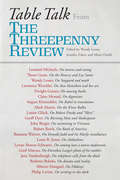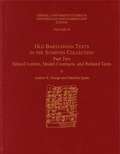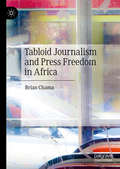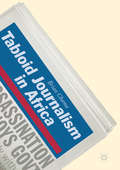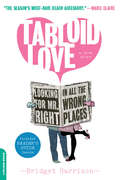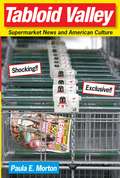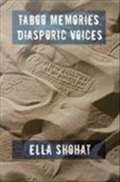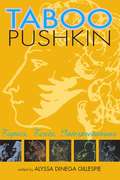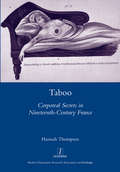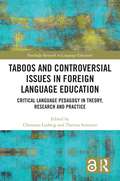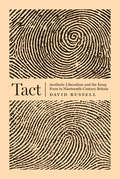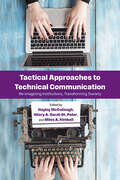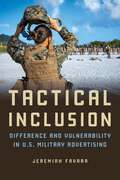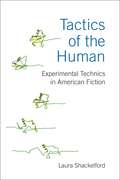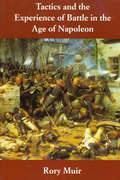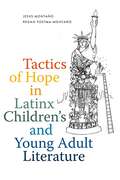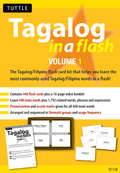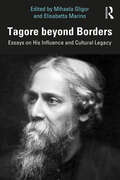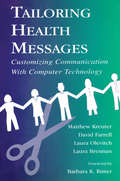- Table View
- List View
Table Lands: Food in Children's Literature (Children's Literature Association Series)
by Kara K. Keeling Scott T. PollardFood is a signifier of power for both adults and children, a sign of both inclusion and exclusion and of conformity and resistance. Many academic disciplines—from sociology to literary studies—have studied food and its function as a complex social discourse, and the wide variety of approaches to the topic provides multidisciplinary frames for understanding the construction and uses of food in all types of media, including children’s literature. Table Lands: Food in Children’s Literature is a survey of food’s function in children’s texts, showing how the sociocultural contexts of food reveal children’s agency. Authors Kara K. Keeling and Scott T. Pollard examine texts that vary from historical to contemporary, noncanonical to classics, and Anglo-American to multicultural traditions, including a variety of genres, formats, and audiences: realism, fantasy, cookbooks, picture books, chapter books, YA novels, and film. Table Lands offers a unified approach to studying food in a wide variety of texts for children. Spanning nearly 150 years of children’s literature, Keeling and Pollard’s analysis covers a selection of texts that show the omnipresence of food in children’s literature and culture and how they vary in representations of race, region, and class, due to the impact of these issues on food. Furthermore, they include not only classic children’s books, such as Winnie-the-Pooh, but recent award-winning multicultural novels as well as cookbooks and even one film, Pixar’s Ratatouille.
Table Talk: From the Threepenny Review
by Wendy Lesser Jennifer Zahrt Mimi ChubbTable Talk is a portable dinner party and a book to read alone while laughing out loud. Table Talk is a salon attended by your smartest friends and by all of the wittiest people they know. <P><P>Table Talk is a collection of brief but critically acclaimed, half serious/half tongue-in-cheek pieces that borrow the format of The New Yorker's "Talk of the Town" column. Selected from several decades of The Threepenny Review, known colloquially as the West Coast's New York Review of Books, these anecdotal essays debate the historical, artistic, and technological developments of our time.Released to coincide with the 35th anniversary of The Threepenny Review in January 2015, Table Talk, edited by Wendy Lesser, Mimi Chubb and Jennifer Zahrt, includes essays by Christopher Ricks, who unfolds a dazzling literary history of the phrase "Table Talk"; Leonard Michaels on why the waltz should be viewed as an aggressive, imperialist dance; and Claire Messud on the art of digression in fiction and conversation. Sigrid Nunez engages with the contemporary vogue for memoir and autobiography, while Luc Sante draws conclusions about postmodern art from a stray bit of graffiti glimpsed on a New York street. Other contributions include Alexander Nehamas on the NEA controversy that roiled the culture wars of the 1990s and Paula Fox's tips for interacting with difficult children.Ninety-nine pieces become a garden of literary delights, as Table Talk takes an irreverent walk on the wild side of philosophical and cultural speculation that will resonate with readers of any age.
Tablets from the Iri-saĝrig Archive (CUSAS)
by Marcel Sigrist Tohru OzakiWhile each of the previously known archives from the Third Dynasty of Ur has provided distinct views of Sumerian society, those from Iri-Saĝrig present an extraordinary range of new sources, depicting a cosmopolitan Sumerian/Akkadian city unlike any other from this period. In this publication, Marcel Sigrist and Tohru Ozaki present more than two thousand newly identified tablets, mostly from Iri-Saĝrig. This unique and extensive corpus elucidates the importance that Iri-Saĝrig represented politically, militarily, and culturally in Sumer.Although these tablets were not able to be cleaned, baked, or photographed, the authors’ transliterations are based on the original tablets, often after repeated collations. Moreover, access to so many well-preserved tablets made it possible to improve upon the readings and interpretations offered in previous publications. Volume 1 contains a catalog and classification of the texts by provenance, a list of month names and year formulas, another of inscriptions, a chronological listing of the texts, and extensive indexes of personal names, deities, toponyms, and selected words and phrases. Volume 2 presents the texts in transliteration with substantial commentary.This two-volume publication preserves and makes available to the scholarly community a significant segment of Iraq’s cultural legacy that otherwise might have been ignored or even lost. It will augment and enhance our understanding of the unique civilization of Mesopotamia in the late third millennium BCE.
Tablets from the Irisaĝrig Archive (CUSAS: Cornell University Studies in Assyriology and Sumerology #40)
by Marcel Sigrist Tohru OzakiWhile each of the previously known archives from the Third Dynasty of Ur has provided distinct views of Sumerian society, those from Iri-Saĝrig present an extraordinary range of new sources, depicting a cosmopolitan Sumerian/Akkadian city unlike any other from this period. In this publication, Marcel Sigrist and Tohru Ozaki present more than two thousand newly identified tablets, mostly from Iri-Saĝrig. This unique and extensive corpus elucidates the importance that Iri-Saĝrig represented politically, militarily, and culturally in Sumer.Although these tablets were not able to be cleaned, baked, or photographed, the authors’ transliterations are based on the original tablets, often after repeated collations. Moreover, access to so many well-preserved tablets made it possible to improve upon the readings and interpretations offered in previous publications. Volume 1 contains a catalog and classification of the texts by provenance, a list of month names and year formulas, another of inscriptions, a chronological listing of the texts, and extensive indexes of personal names, deities, toponyms, and selected words and phrases. Volume 2 presents the texts in transliteration with substantial commentary.This two-volume publication preserves and makes available to the scholarly community a significant segment of Iraq’s cultural legacy that otherwise might have been ignored or even lost. It will augment and enhance our understanding of the unique civilization of Mesopotamia in the late third millennium BCE.
Tabloid Journalism and Press Freedom in Africa
by Brian ChamaThis book studies tabloid journalism newspapers within the broader context of press freedom in Africa. After defining tabloid journalism and professional practices within various political contexts, the book then proceeds to consider tabloids in Southern Africa and emerging cyberspace laws. Many factors of press freedom are considered, including the impact of public order and national security laws on tabloids in North Africa, the impact of defamation laws on tabloids in West Africa, the impact of the fake news laws on tabloids in East Africa, and the impact of sedition and treason laws on tabloids in Central Africa. Exploring tabloid journalism and press freedom in Arabic, Portuguese, and Francophone speaking countries across Africa, this book is a unique addition to this emerging field. The book concludes by providing a synthesis of the developing patterns from the cases analysed and by looking to the future to make recommendations and map the challenges and the successes.
Tabloid Journalism in Africa
by Brian ChamaBrian Chama provides a timely and important summary of tabloid journalism in Africa, which clearly shows how tabloids in the African context play a unique role in the democratization process. Prior to this book, very little was known about how tabloid journalists operate in Africa. The book first explores the global practice of journalism and then focuses on tabloid journalism - finally situating the discussion within the African context. As well as concentrating on how tabloid journalism can be seen as part of the broader neo-liberal thinking in Africa, in which democracy and freedom of expression is promoted, it also looks at how tabloid journalism practice has been met with resistance from the alliance of forces. Chama draws on examples from across the continent looking at success stories and struggles within the sometime infotainment genre. Tabloid Journalism in Africa concludes that even though challenges exist, there is a strong case to suggest that the practice of tabloid journalism is being readily accepted by many people as part of the unique voices of democracy - even those which might be shocking yet true.
Tabloid Love: Looking for Mr. Right in All the Wrong Places
by Bridget HarrisonDubbed one of the summer’s hottest beach reads by People, Glamour, Cosmo, and the Weekend "Today” show, Tabloid Love introduces Bridget Harrison, an almost thirty-year-old Brit and rookie reporter for the New York Post. While her London friends begin to marry, Bridget chases her dream of becoming a hard-news journalist. But just as she perfects the art of interviewing strangers about ghoulish crimes, she discovers that finding a mate seems impossible in the ultimate singles city. Then Bridget lands her very own Post dating column, and half a million New Yorkers read about her weekly romantic disasters. Whether covering celebrity parties in the Hamptons or struggling to hide her inter-office crush, Bridget retains such humor and humility "you’ll not only root for her, you’ll wish she were your best friend. ” (Harper’s Bazaar)
Tabloid Valley: Supermarket News and American Culture
by Paula E MortonWith sensational headlines and scandalous photos, supermarket tabloids dish out the dirt on everyone and everything from space aliens and Bat Boy to Elvis and Britney. Although they were once the pariah of traditional journalism, tabloids have gained credibility in recent years and today their lurid style--and sometimes their reportage--is even imitated by mainstream news outlets. In Tabloid Valley, Paula Morton explores the cultural impact of the sensationalist press over the years, focusing on Generoso Pope Jr.'s decision in 1971 to move the editorial offices of the National Enquirer from New Jersey to Florida. This bold step initiated a mass exodus of similar publications to the Sunshine State where six of the largest circulation weeklies--the Star, the Globe, the Weekly World News, the Sun, the National Examiner, and the Enquirer--were eventually consolidated under a single owner, American Media, Inc. Florida's favorable business climate and a booming southern frontier created the perfect environment for the tabloids and their writers to flourish.Morton goes behind the scenes to examine every facet of modern yellow journalism: what headlines sell and why, how the journalists gather the news, the recent and ongoing downturn in circulation, what the tabloids are doing to maintain their foothold, and, most important, what the tabloid news says about American culture.
Tabloiding the Truth: It's the Pun Wot Won It
by Steve BuckledeeWhat skills do journalists exhibit in sensationalising, exaggerating and otherwise ‘tabloiding’ the truth, while usually stopping short of stating unambiguous falsehoods? Why has the tabloid news not collapsed as predicted, but thrived as a medium in an age of interaction and online commentary? This book is a comprehensive and accessible exploration of the British tabloid newspapers from the 1960s to the present day. Examining topics such as sex and the representation of women, national stereotypes and Britain’s relationship with Europe, war coverage, celebrities, investigative journalism and instances where the tabloids have misread the public mood, the author draws on Critical Discourse Analysis and Stylistics to take a language-led approach to the UK tabloids. With its interdisciplinary approach and readable prose style, this book will be of interest to a wide range of readers across language and linguistics, media and communication, journalism, political science and British cultural studies.
Taboo Memories, Diasporic Voices
by Ella ShohatTaboo Memories, Diasporic Voices brings together for the first time a selection of trailblazing essays by Ella Shohat, an internationally renowned theorist of postcolonial and cultural studies of Iraqi-Jewish background. Written over the past two decades, these twelve essays--some classic, some less known, some new--trace a powerful intellectual trajectory as Shohat rigorously teases out the consequences of a deep critique of Eurocentric epistemology, whether to rethink feminism through race, nationalism through ethnicity, or colonialism through sexuality. Shohat's critical method boldly transcends disciplinary and geographical boundaries. She explores such issues as the relations between ethnic studies and area studies, the paradoxical repercussions for audio-visual media of the "graven images" taboo, the allegorization of race through the refiguring of Cleopatra, the allure of imperial popular culture, and the gender politics of medical technologies. She also examines the resistant poetics of exile and displacement; the staging of historical memory through the commemorations of the two 1492s, the anomalies of the "national" in Zionist discourse, the implications of the hyphen in the concept "Arab-Jew," and the translation of the debates on orientalism and postcolonialism across geographies. Taboo Memories, Diasporic Voices not only illuminates many of the concerns that have animated the study of cultural politics over the past two decades; it also points toward new scholarly possibilities.
Taboo Pushkin
by Stephen G. SappSince his death in 1837, Alexander Pushkin—often called the “father of Russian literature”—has become a timeless embodiment of Russian national identity, adopted for diverse ideological purposes and reinvented anew as a cultural icon in each historical era (tsarist, Soviet, and post-Soviet). His elevation to mythic status, however, has led to the celebration of some of his writings and the shunning of others. Throughout the history of Pushkin studies, certain topics, texts, and interpretations have remained officially off-limits in Russia—taboos as prevalent in today’s Russia as ever before. Â Â Â The essays in this bold and authoritative volume use new approaches, overlooked archival materials, and fresh interpretations to investigate aspects of Pushkin’s biography and artistic legacy that have previously been suppressed or neglected. Taken together, the contributors strive to create a more fully realized Pushkin and demonstrate how potent a challenge the unofficial, taboo, alternative Pushkin has proven to be across the centuries for the Russian literary and political establishments.
Taboo: Corporeal Secrets in Nineteenth-century France
by Hannah ThompsonFrench realist texts are driven by representations of the body and depend on corporeality to generate narrative intrigue. But anxieties around bodily representation undermine realist claims of objectivity and transparency. Aspects of bodily reality which threaten les bonnes moeurs - gender confusion, sexual appetite, disability, torture, murder, child abuse and disease - rarely occupy the foreground and are instead spurned or only partially alluded to by writers and critics. This wide-ranging study uses the notion of the taboo as a powerful means of interpreting representations of the body. The hidden bodies of realist texts reveal their secrets in unexpected ways. Thompson reads texts by Sand, Rachilde, Maupassant, Hugo, Barbey d'Aurevilly, Mirbeau and Zola alongside modern theorists of the body to show how the figure of the taboo plots an alternative model of author-reader relations based on the struggle to speak the unspeakable. Dr Hannah Thompson is a Senior Lecturer in French at Royal Holloway, University of London. Her first book, Naturalism Redressed: Identity and Clothing in the Novels of Emile Zola, was published by Legenda in 2004.
Taboos and Controversial Issues in Foreign Language Education: Critical Language Pedagogy in Theory, Research and Practice (Routledge Research in Language Education)
by Christian LudwigThis edited volume provides innovative insights into how critical language pedagogy and taboo topics can inform and transform the teaching and learning of foreign languages. The book investigates the potential as well as the challenges involved in dealing with taboo topics in the foreign language classroom. Traditionally subsumed under the acronym PARSNIP (politics, alcohol, religion, narcotics, isms, and pork). By examining how additional controversial topics such as disability, racism, conspiracy theories and taboo language can be integrated into conceptual teaching frameworks and teaching practice, this edited volume draws on examples from literary texts and pop culture such as young adult novels, music videos, or rap songs and investigates their potential for developing critical literacies. The book considers foreign language teaching outside of English teaching contexts and sets the groundwork for addressing the integration of taboo topics in foreign language education theory, research, and practice. Filling an important gap in educational research, the book will be of great interest to researchers, academics, and students of foreign language education, critical pedagogy, and applied linguistics. It will also be useful reading for teacher trainers and educators of foreign language education.
Tackling Tough Texts: A Research-Based Guide to Scaffolding Learning in Grades 6–12
by Sarah M. Lupo Christine Hardigree Dan ReynoldsFilling a crucial need, this book provides concrete ways to support all students in grades 6–12 as they engage with rigorous grade-level texts in English language arts, science, and social studies. The authors offer fresh insights into adolescent reading and what makes a given text "tough"--including knowledge demands, text structure and complexity, vocabulary, and more. Research-based, step-by-step strategies are presented for explicitly scaffolding these challenges in the context of purposeful learning activities that leverage students' individual strengths and interests. The book includes planning tips, text selection guidelines, sample text sets, and vivid case studies from culturally and linguistically diverse classrooms. Fourteen reproducible forms and handouts can be photocopied or downloaded for use with students.
Tact: Aesthetic Liberalism and the Essay Form in Nineteenth-Century Britain
by David RussellThe social practice of tact was an invention of the nineteenth century, a period when Britain was witnessing unprecedented urbanization, industrialization, and population growth. In an era when more and more people lived more closely than ever before with people they knew less and less about, tact was a new mode of feeling one’s way with others in complex modern conditions. In this book, David Russell traces how the essay genre came to exemplify this sensuous new ethic and aesthetic.Russell argues that the essay form provided the resources for the performance of tact in this period and analyzes its techniques in the writings of Charles Lamb, John Stuart Mill, Matthew Arnold, George Eliot, and Walter Pater. He shows how their essays offer grounds for a claim about the relationship among art, education, and human freedom—an “aesthetic liberalism”—not encompassed by traditional political philosophy or in literary criticism. For these writers, tact is not about codes of politeness but about making an art of ordinary encounters with people and objects and evoking the fullest potential in each new encounter. Russell demonstrates how their essays serve as a model for a critical handling of the world that is open to surprises, and from which egalitarian demands for new relationships are made.Offering fresh approaches to thinking about criticism, sociability, politics, and art, Tact concludes by following a legacy of essayistic tact to the practice of British psychoanalysts like D. W. Winnicott and Marion Milner.
Tactical Approaches to Technical Communication: Reimagining Institutions, Transforming Society (SUNY series, Studies in Technical Communication)
by Hayley McCullough; Hilary A. Sarat-St. Peter; Miles A. KimballDelves into how individuals tactically exist within communicative systems, carving out spaces for themselves in places they don't necessarily fit.In 1984, Michel de Certeau described the terms "strategies" as how institutions communicate their wants/demands/desires and "tactics" as how individuals navigate these potentially hostile, unwelcoming systems. A little over two decades later, Miles A. Kimball solidified the idea of tactical technical communication, laying the foundations for a new area of inquiry and scholarship. Today, many academics and researchers have imbued the concept of tactical technical communication with their own ideas and perspectives. This essay collection spotlights a meaningful diversity of tactical technical communication scholarship, exploring topics like the feminist punk magazine BIKINI KILL, the phenomenon of copwatching, the usage of fictional narratives in technical writing courses, and the challenges of LBGTQ+ visibility in local libraries. In many ways, the contributors are partaking in their own forms of tactical communication as they carve out spaces for themselves and their ideas within the academic discourse.
Tactical Inclusion: Difference and Vulnerability in U.S. Military Advertising (Feminist Media Studies)
by Jeremiah FavaraThe revolution in military recruitment advertising to people of color and women played an essential role in making the US military one of the most diverse institutions in the United States. Starting at the dawn of the all-volunteer era, Jeremiah Favara illuminates the challenges at the heart of military inclusion by analyzing recruitment ads published in three commercial magazines: Sports Illustrated, Cosmopolitan, and Ebony. Favara draws on Black feminism, critical race theory, and queer of color critique to reveal how the military and advertisers affected change by deploying a set of strategies and practices called tactical inclusion. As Favara shows, tactical inclusion used representations of servicemembers in the new military to connect with people susceptible to recruiting efforts and rendered these new audiences vulnerable to, valuable to, and subject to state violence. Compelling and eye-opening, Tactical Inclusion combines original analysis with personal experience to chart advertising’s role in building the all-volunteer military.
Tactics Of The Human: Experimental Technics In American Fiction
by Laura ShackelfordTactics of the Human returns to American fiction published during the 1990s, formative years for digital cultures, to reconsider these narratives' comparative literary print methods of critically engaging with digital technologies and their now ubiquitous computation-based modes of circulation, scenes of writing, and social spaces. It finds that fiction by John Barth, Shelley Jackson, Leslie Marmon Silko, Ruth L. Ozeki, and Jeffrey Eugenides, by creatively transposing digital writing, material formats, and spatiotemporal orientations into print, registers shifting relations to technologies at multiple sites and scales. Grappling with the digital practices catalyzed by post-World War II biological, information, and systems theory, these literary narratives tactically enlist, and enable speculative diagnoses of, emerging relations to digital technologies. Their experimental technics comparatively retrace emerging relations to the digital as these impact American nationalisms and their transnational economic networks; processes of gendering and racialization that remain crucial to differential discourses of the human; and as they enter, unnoticed, into micropractices of everyday life and lived space. In the midst of expanding technoscientific processes of digital de- and re-materialization that render multiple, charged boundaries of the human increasingly plastic, Tactics of the Human illustrates why it is ever more crucial to query and assess the divergent (re)understandings of the human now categorized, quite loosely, as posthumanisms with particular attention to women's, subalterns', and other knowledges already considered liminal to the human. It identifies here and pursues strains of systems thinking, informed by feminist, new materialist, queer, and subaltern understandings of material practices, revealing why these are so pivotal to ongoing efforts to assess current limits to digital technics and expand upon their biological, cultural, social, and poetic potentialities.
Tactics and the Experience of Battle in the Age of Napoleon
by Rory MuirThis historical study of Napoleonic battles and tactics examines firsthand accounts from soldiers&’ memoirs, diaries, and letters: &“A major work&” (David Seymour, Military Illustrated). In this illuminating volume, historian Rory Muir explores what actually happened in battle during the Napoleonic Wars, putting special focus on how the participants&’ feelings and reactions influenced the outcome. Looking at the immediate dynamics of combat, Muir sheds new light on how Napoleon&’s tactics worked. This analysis is enhanced with vivid accounts of those who were there—the frightened foot soldier, the general in command, the young cavalry officer whose boils made it impossible to ride, and the smartly dressed aide-de-camp, tripped up by his voluminous pantaloons. Muir considers the interaction of artillery, infantry, and cavalry; the role of the general, subordinate commanders, staff officers, and aides; morale, esprit de corps, soldiers&’ attitudes toward death and feelings about the enemy; the plight of the wounded; the difficulty of surrendering; and the way victories were finally decided. He discusses the mechanics of musketry, artillery, and cavalry charges and shows how they influenced the morale, discipline, and resolution of the opposing armies. "Muir has filled an important gap in the study of the Napoleonic era."—Library Journal
Tactics of Hope in Latinx Children's and Young Adult Literature
by Jesus Montaño Regan Postma-MontañoUsing Gloria Anzaldúa&’s theories of conocimiento as a critical lens, the authors examine several literary works including Side by Side / Lado a lado; They Call Me Güero; Land of the Cranes; Efrén Divided; and Gabi, a Girl in Pieces.
Tagalog in a Flash Volume 1
by Edwin LimTagalog in a Flash: Volume I is an excellent new language learning resource for beginning students of Tagalog.Tagalog is the national language of the Philippines, and the beloved language of the second-largest Asian-American ethnic group.<P><P>With a full range of features to help beginners and intermediate learners, Tagalog in a Flash Volume 1 is an excellent learning tool for anyone who wants to master Tagalog (also known as Filipino). Containing 448 flash cards of the most commonly used Tagalog words and phrases, along with sample sentences, handy indexes and a guide to using the cards for most effective learning, Tagalog in a Flash Volume 1 delivers.Contains 448 flash cars plus a 16 page index booklet.Learn 448 main words plus 1,792 related words, phrases and expressions.Pronunciation and accent marks given for all 448 main words.Arranged and sequenced in thematic groups and usage frequency.
Tagore and the Margins of the Nation under Colonialism
by Amartya MukhopadhyayThis book focuses on India’s anti-colonial politics which Rabindranath Tagore (1861–1941) brought into the mainstream of nationalist thinking. It browses through the entire corpus of Tagore’s writings in the genres of poetry, fiction, and essays, to glean both used and hitherto unused/un-translated writings that illumine Tagore’s gender consciousness and (proto)feminist thought and empathy, presenting it in a wholly new light. It teases out Tagore’s original views on India’s industrial-capitalist development and his views on the roles of applied scientists and engineers in it to highlight his critique of the nature of science teaching in colonial India. The volume also delineates Tagore’s Upanişadic ecologism that creatively evoked anticolonialism and patriotism. Lucid and topical, the book will be indispensable for students and researchers in the fields of comparative literature, history, political science, international relations, and sociology at all levels, and anybody interested in literary criticism and cultural studies.
Tagore beyond Borders: Essays on His Influence and Cultural Legacy
by Mihaela Gligor Elisabetta MarinoThis book looks at Rabindranath Tagore’s creative art, social commitment, literary and artistic representation and his unique legacy in the cultural history of modern India – as a blend of the quintessentially Indian and the liberal universalist. Tagore’s genius, which he expressed through his poetry, songs, paintings, drama and philosophy, is celebrated across the globe. In 1913, he was awarded the Nobel Prize for Literature for his volume of poetry, Gitanjali (Song Offerings), making him the first Nobel laureate from Asia. This volume of essays celebrates his intellectual engagements and his incredible legacy by discussing the diverse ways in which his works have been reinterpreted, adapted and translated over the years. It analyses his perspectives on modernity, nationalism, liberation, education, post-colonialism and translatability and their relevance today. The leitmotif is a Tagore who, while imaginable as made possible only within the Indian tradition, eludes attempts aimed at identification with a national culture and remains a "cosmopolitan" in the best sense of the term.This volume will be of interest to readers and researchers in the fields of literature, philosophy, political science, cultural studies, Asian studies, South Asian studies and Tagore studies. Fans of Tagore will also find this an interesting read as it presents many little knows aspects of the poet’s work.
Tailoring Health Messages: Customizing Communication With Computer Technology
by Matthew W. Kreuter David W. Farrell Laura R. Olevitch Laura K. BrennanThrough the use of new technologies, researchers, and practitioners in health education and health communication can now provide health information and behavior change strategies that are customized based on the unique needs, interests, and concerns of different individuals. These tailored health messages can be highly effective in assisting individuals in understanding and responding to health concerns. In this volume, Matthew Kreuter, David Farrell, and their colleagues define the process of tailoring and describe its uses in health communication programs. They present a theoretical and public health rationale for tailoring and support their position with empirical evidence. They also lay out the steps involved in creating and delivering tailored health communication programs, which can then be applied in practice. Practitioners, researchers, and students in health communication, health psychology, public health, and related areas will find this book to be a vital and invaluable resource for improving communication about health issues.

